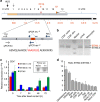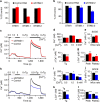A STIM2 splice variant negatively regulates store-operated calcium entry
- PMID: 25896806
- PMCID: PMC4411291
- DOI: 10.1038/ncomms7899
A STIM2 splice variant negatively regulates store-operated calcium entry
Abstract
Cellular homeostasis relies upon precise regulation of Ca(2+) concentration. Stromal interaction molecule (STIM) proteins regulate store-operated calcium entry (SOCE) by sensing Ca(2+) concentration in the ER and forming oligomers to trigger Ca(2+) entry through plasma membrane-localized Orai1 channels. Here we characterize a STIM2 splice variant, STIM2.1, which retains an additional exon within the region encoding the channel-activating domain. Expression of STIM2.1 is ubiquitous but its abundance relative to the more common STIM2.2 variant is dependent upon cell type and highest in naive T cells. STIM2.1 knockdown increases SOCE in naive CD4(+) T cells, whereas knockdown of STIM2.2 decreases SOCE. Conversely, overexpression of STIM2.1, but not STIM2.2, decreases SOCE, indicating its inhibitory role. STIM2.1 interaction with Orai1 is impaired and prevents Orai1 activation, but STIM2.1 shows increased affinity towards calmodulin. Our results imply STIM2.1 as an additional player tuning Orai1 activation in vivo.
Figures








Similar articles
-
A cytosolic STIM2 preprotein created by signal peptide inefficiency activates ORAI1 in a store-independent manner.J Biol Chem. 2011 May 6;286(18):16174-85. doi: 10.1074/jbc.M110.206946. Epub 2011 Mar 7. J Biol Chem. 2011. PMID: 21383014 Free PMC article.
-
STIM2 variants regulate Orai1/TRPC1/TRPC4-mediated store-operated Ca2+ entry and mitochondrial Ca2+ homeostasis in cardiomyocytes.Cell Calcium. 2024 May;119:102871. doi: 10.1016/j.ceca.2024.102871. Epub 2024 Mar 19. Cell Calcium. 2024. PMID: 38537434
-
Differential roles for STIM1 and STIM2 in store-operated calcium entry in rat neurons.PLoS One. 2011 Apr 26;6(4):e19285. doi: 10.1371/journal.pone.0019285. PLoS One. 2011. PMID: 21541286 Free PMC article.
-
Unraveling STIM2 function.J Physiol Biochem. 2012 Dec;68(4):619-33. doi: 10.1007/s13105-012-0163-1. Epub 2012 Apr 3. J Physiol Biochem. 2012. PMID: 22477146 Review.
-
STIM and calcium channel complexes in cancer.Biochim Biophys Acta. 2016 Jun;1863(6 Pt B):1418-26. doi: 10.1016/j.bbamcr.2015.10.003. Epub 2015 Oct 9. Biochim Biophys Acta. 2016. PMID: 26455959 Review.
Cited by
-
The SOCE Machinery: An Unbalanced Knowledge between Left and Right Ventricular Pathophysiology.Cells. 2022 Oct 18;11(20):3282. doi: 10.3390/cells11203282. Cells. 2022. PMID: 36291148 Free PMC article. Review.
-
Cross-linking of Orai1 channels by STIM proteins.Proc Natl Acad Sci U S A. 2018 Apr 10;115(15):E3398-E3407. doi: 10.1073/pnas.1720810115. Epub 2018 Mar 26. Proc Natl Acad Sci U S A. 2018. PMID: 29581306 Free PMC article.
-
The role of Orai-STIM calcium channels in melanocytes and melanoma.J Physiol. 2016 Jun 1;594(11):2825-35. doi: 10.1113/JP271141. Epub 2016 Apr 6. J Physiol. 2016. PMID: 26864956 Free PMC article. Review.
-
STIM and Orai1 Variants in Store-Operated Calcium Entry.Front Pharmacol. 2016 Jan 13;6:325. doi: 10.3389/fphar.2015.00325. eCollection 2015. Front Pharmacol. 2016. PMID: 26793113 Free PMC article. Review.
-
SOCE in the cardiomyocyte: the secret is in the chambers.Pflugers Arch. 2021 Mar;473(3):417-434. doi: 10.1007/s00424-021-02540-3. Epub 2021 Feb 27. Pflugers Arch. 2021. PMID: 33638008 Free PMC article. Review.
References
-
- Demaurex N. & Frieden M. Measurements of the free luminal ER Ca(2+) concentration with targeted ‘cameleon' fluorescent proteins. Cell Calcium 34, 109–119 (2003). - PubMed
-
- Prakriya M. E. Store-operated calcium channels. Curr. Top. Membr. 71, 1–273 (2013). - PubMed
-
- Soboloff J. et al.. Orai1 and STIM reconstitute store-operated calcium channel function. J. Biol. Chem. 281, 20661–20665 (2006). - PubMed
-
- Zheng L., Stathopulos P. B., Li G. Y. & Ikura M. Biophysical characterization of the EF-hand and SAM domain containing Ca2+ sensory region of STIM1 and STIM2. Biochem. Biophys. Res. Commun. 369, 240–246 (2008). - PubMed
Publication types
MeSH terms
Substances
LinkOut - more resources
Full Text Sources
Other Literature Sources
Molecular Biology Databases
Research Materials
Miscellaneous

